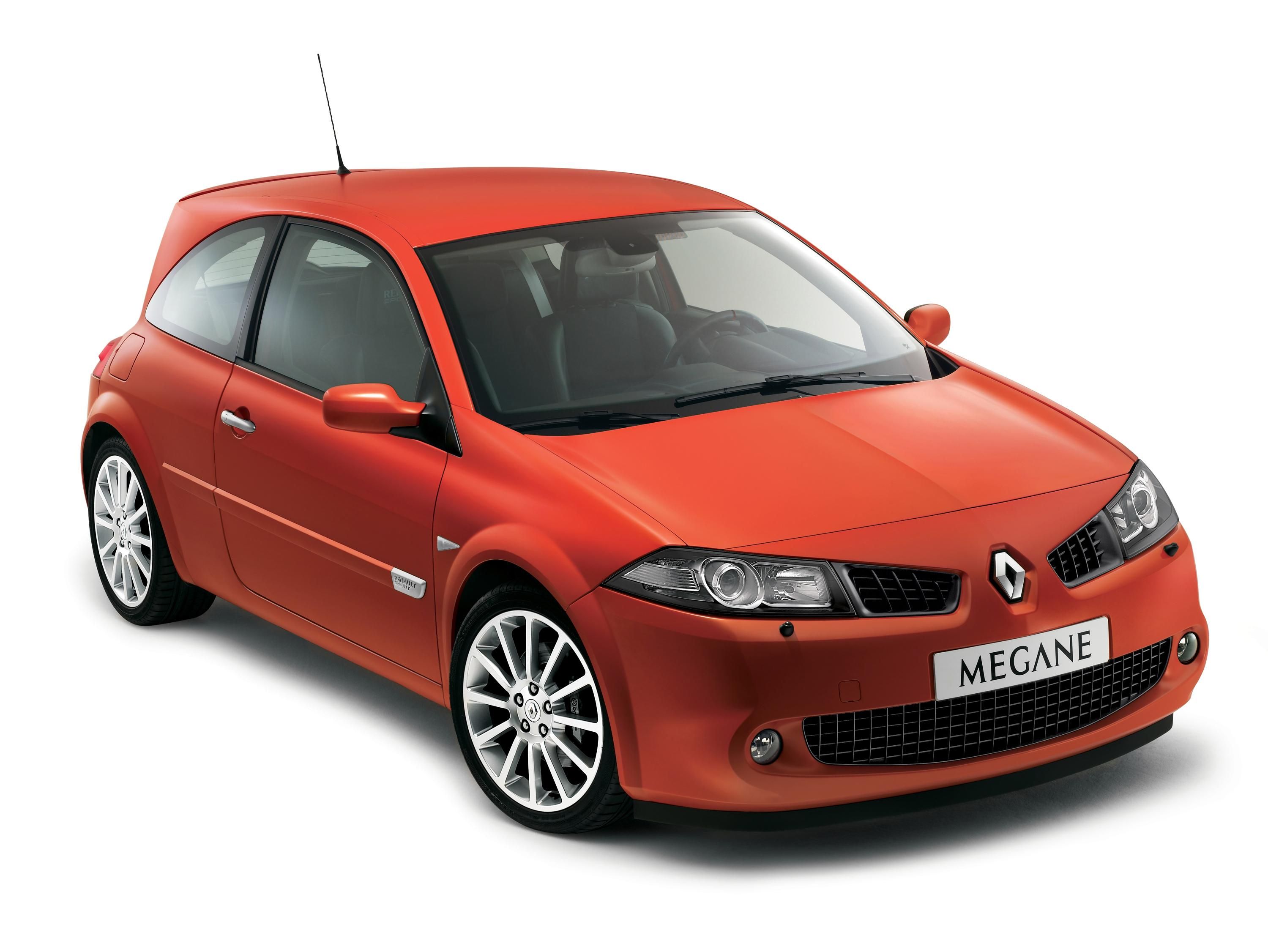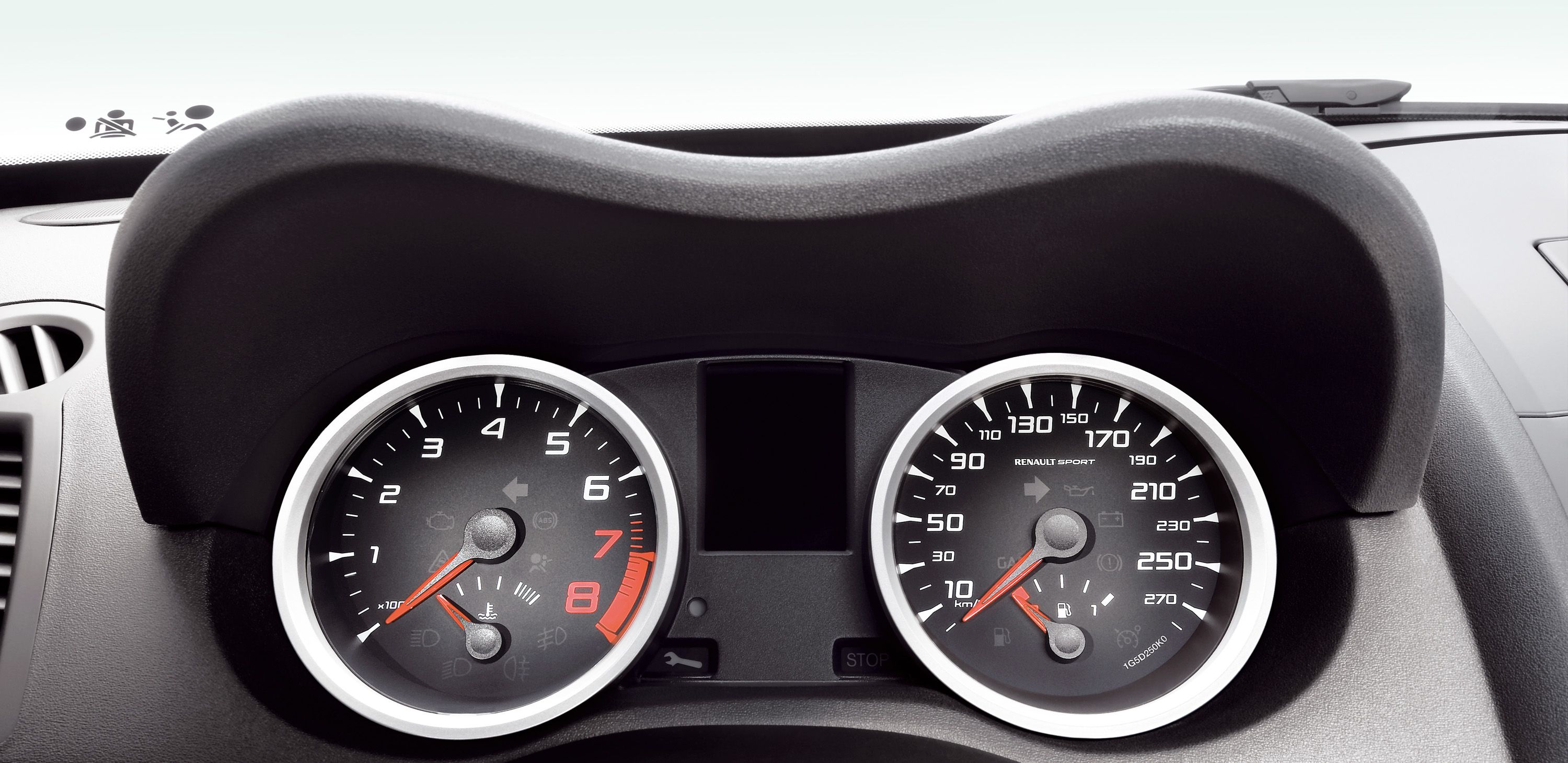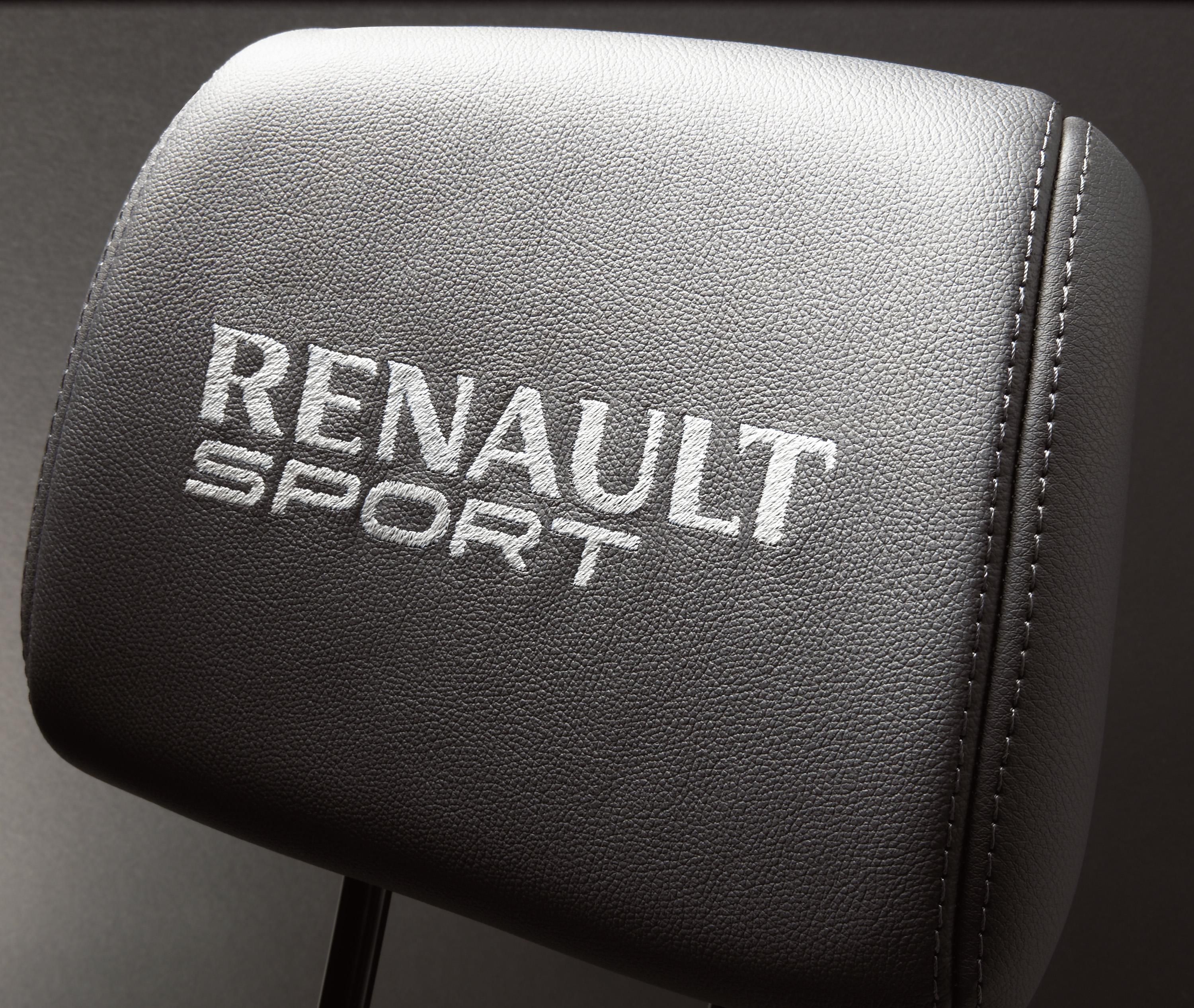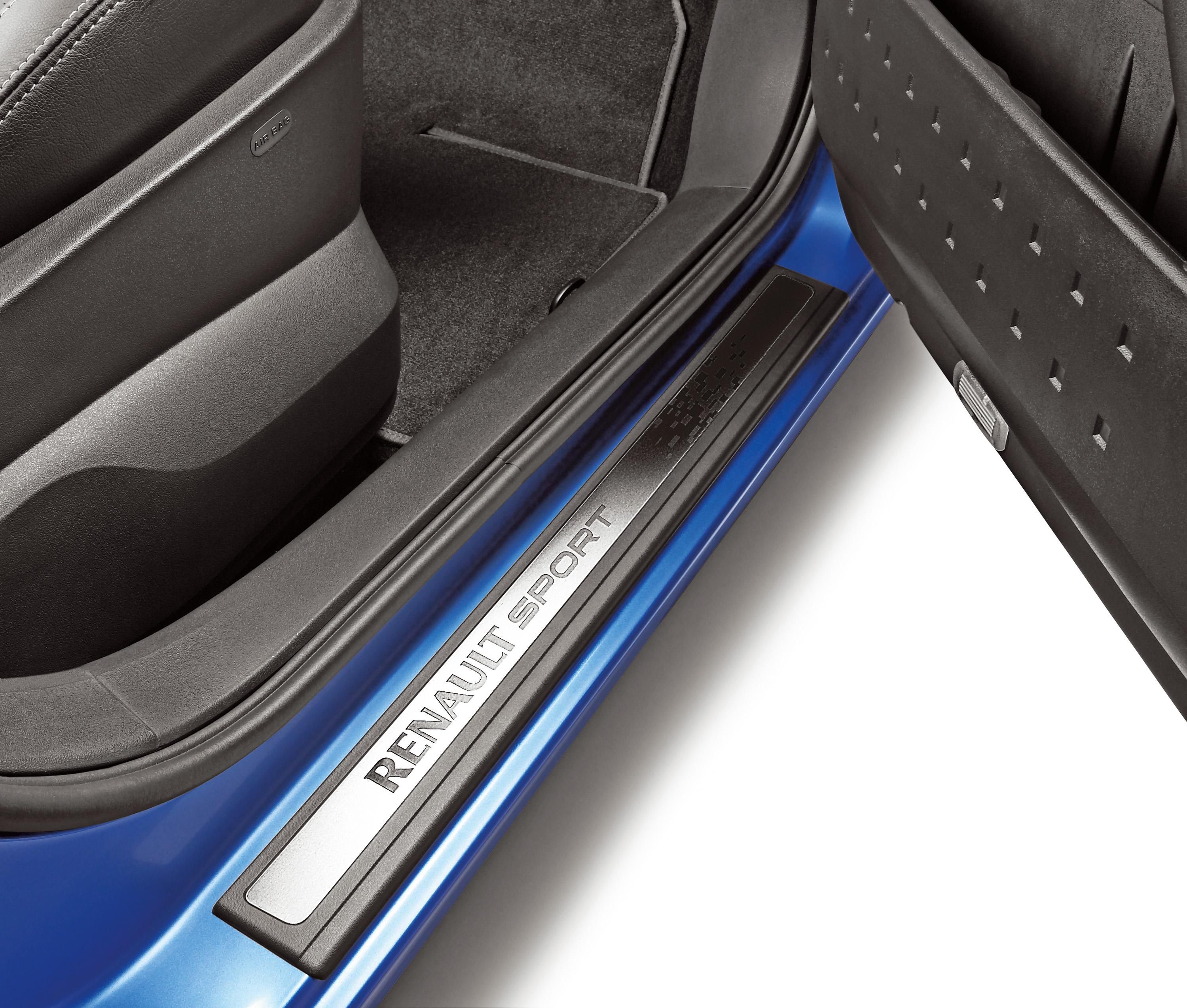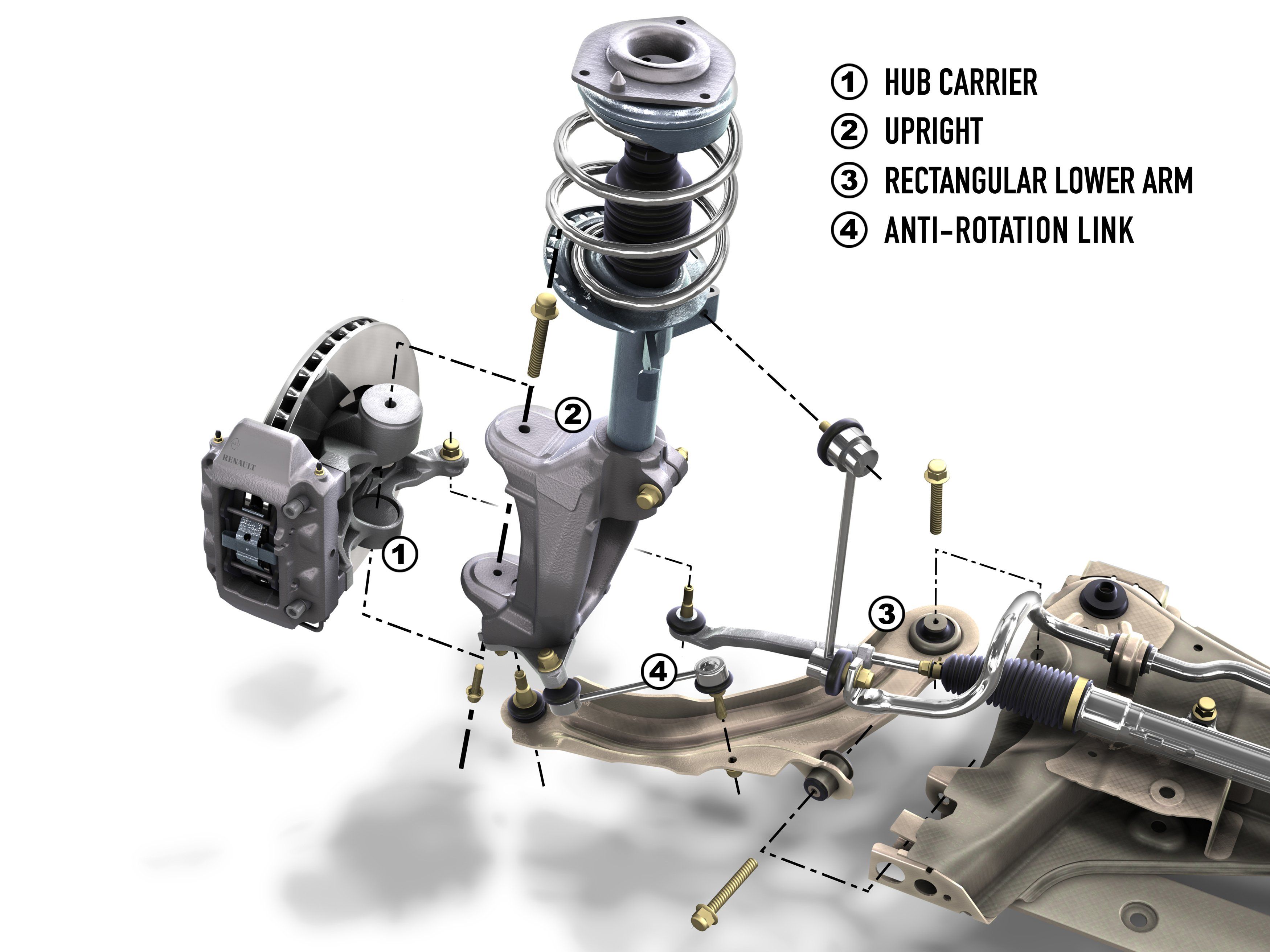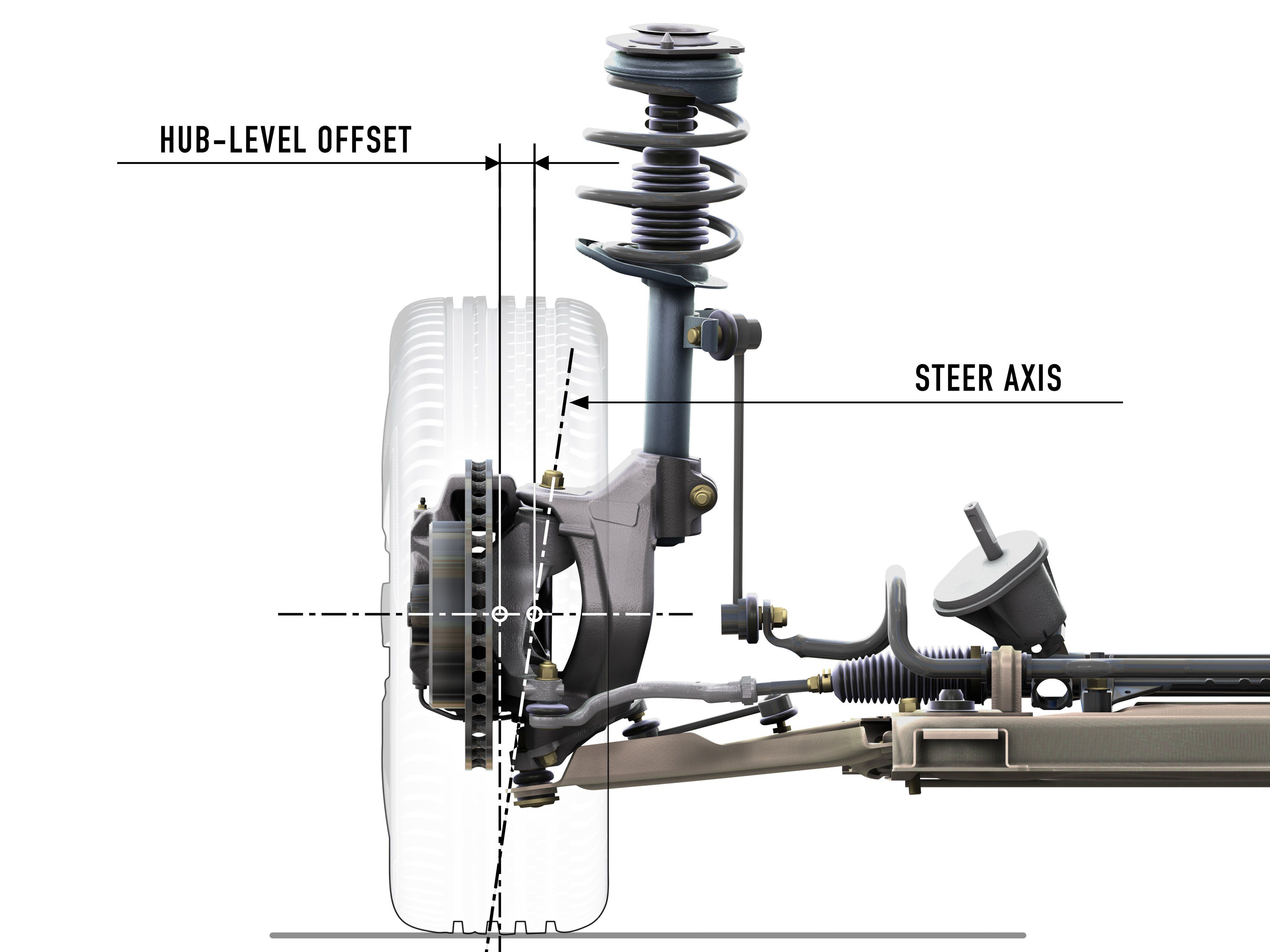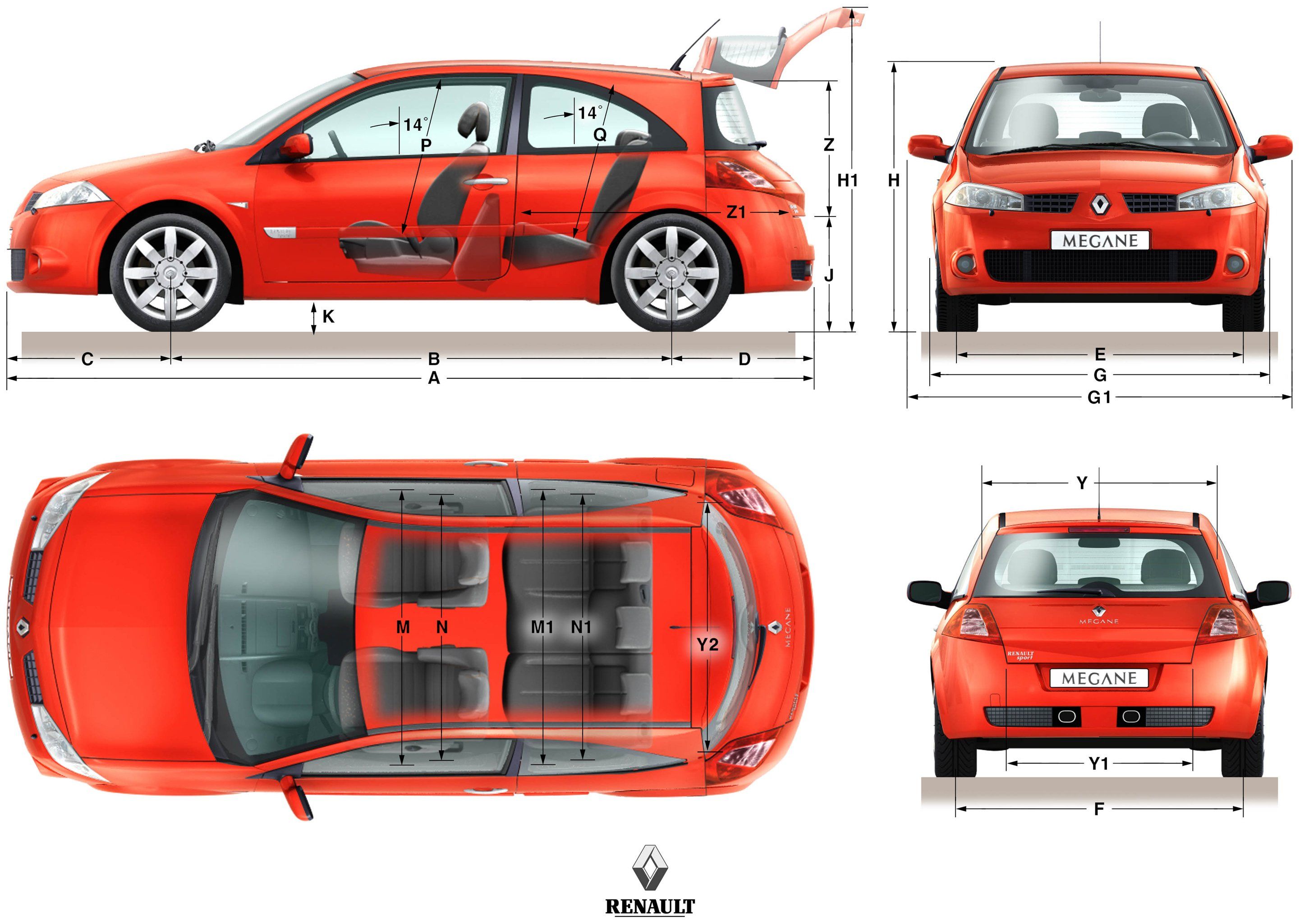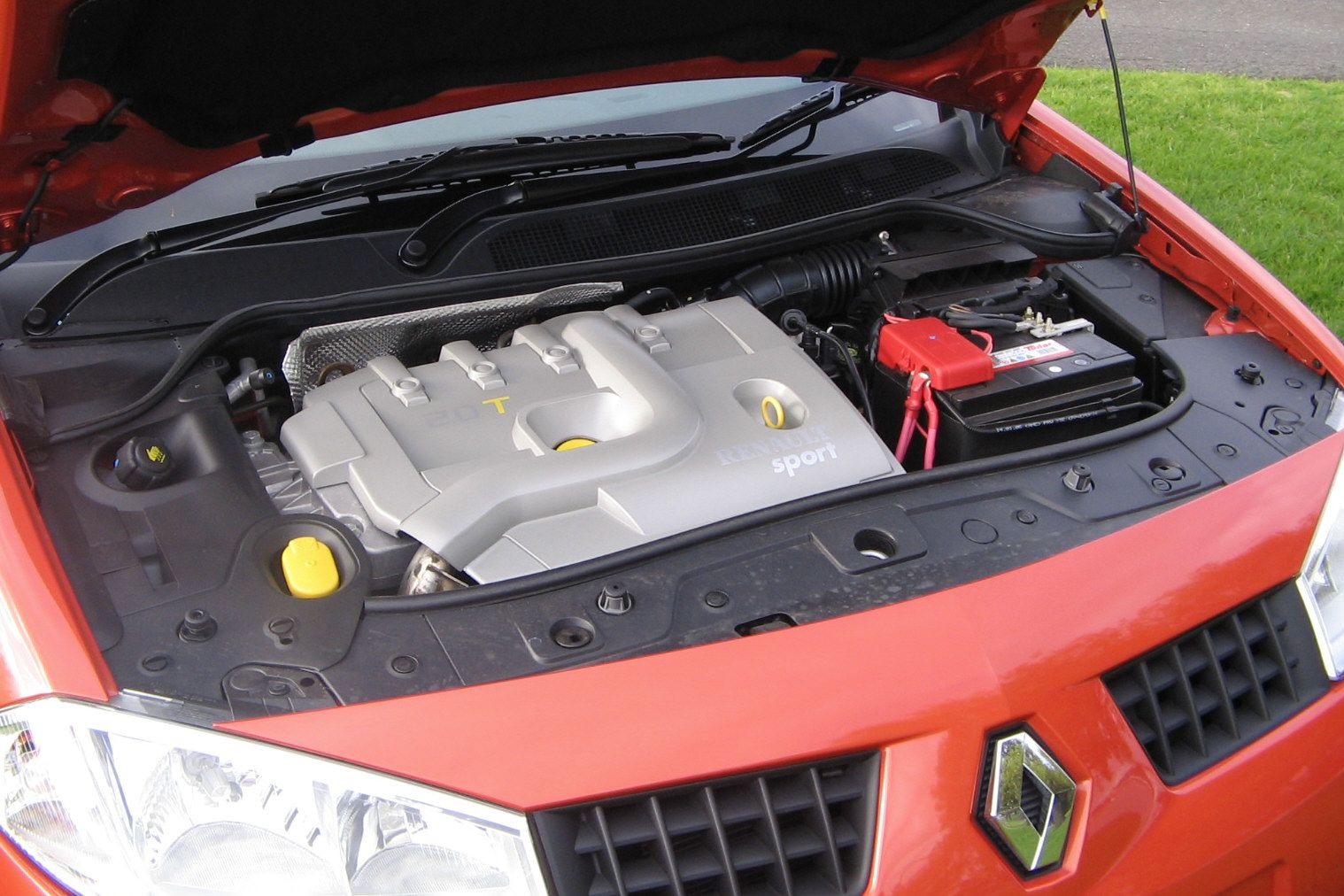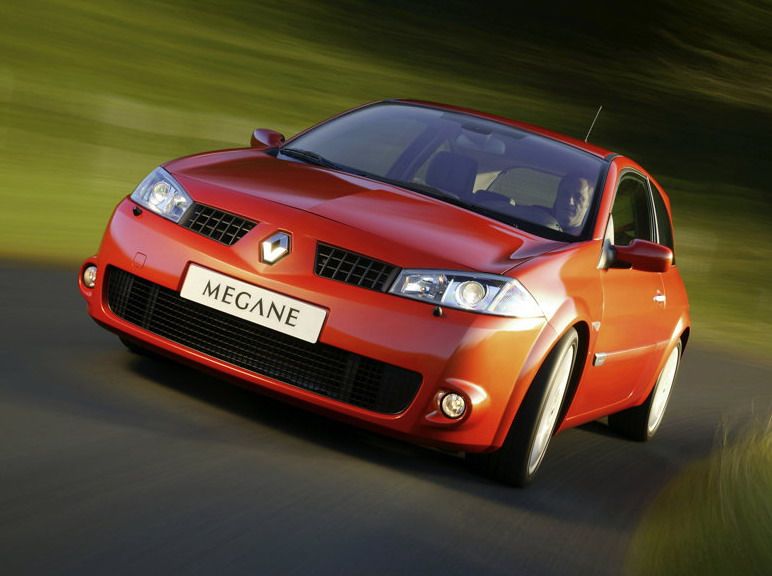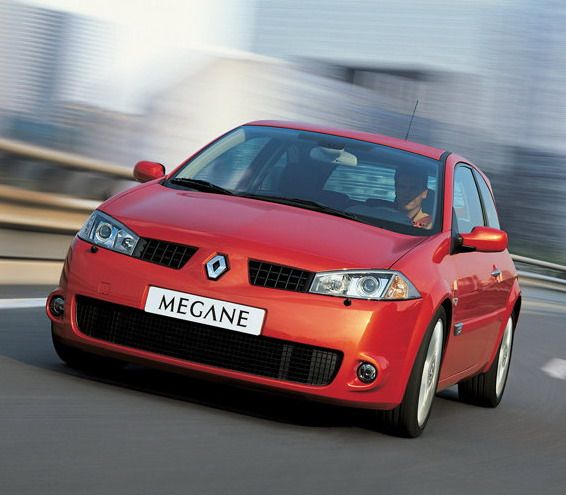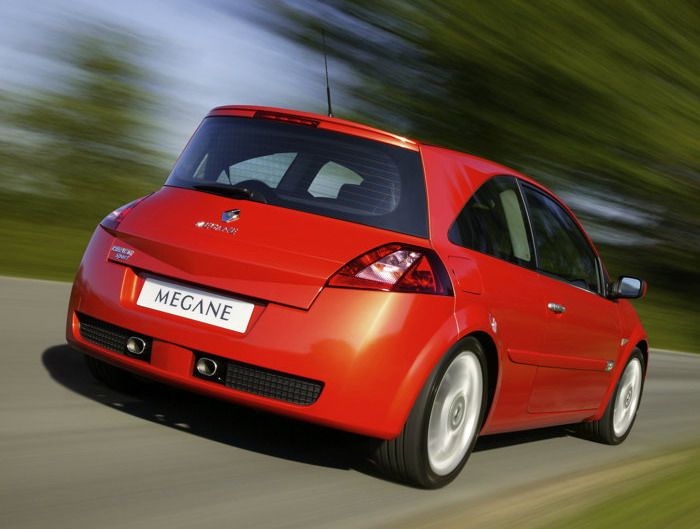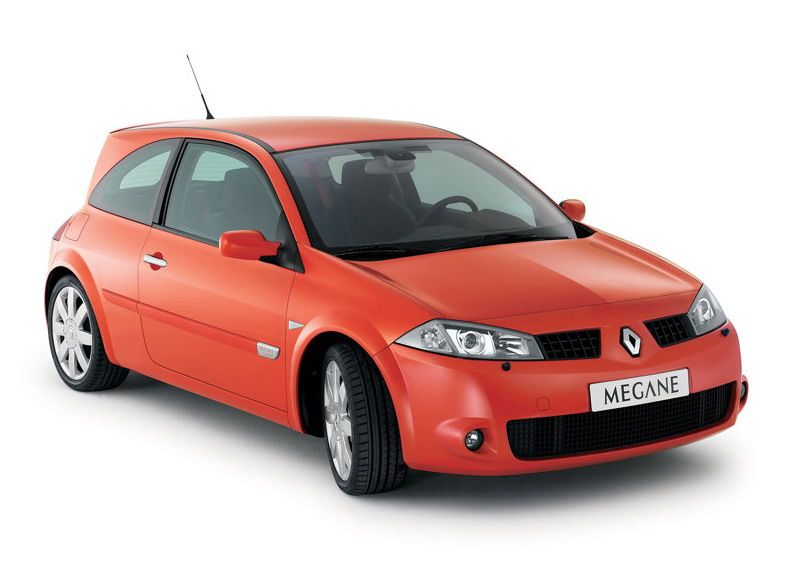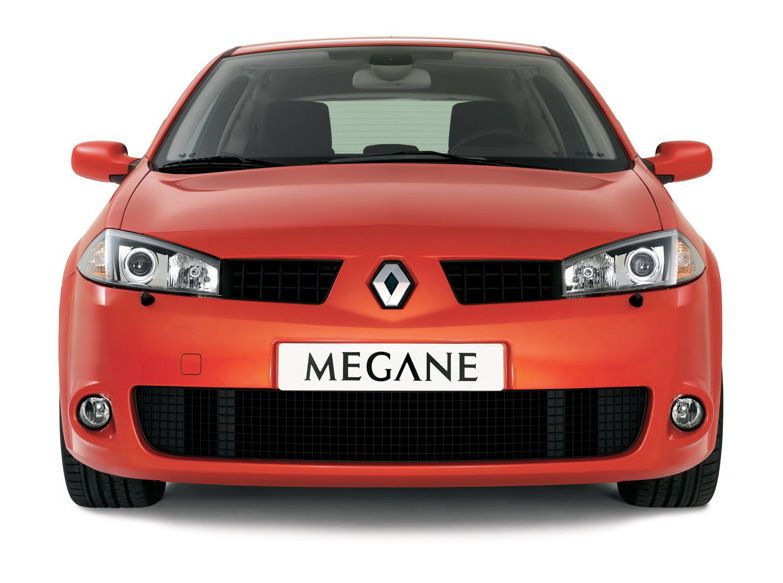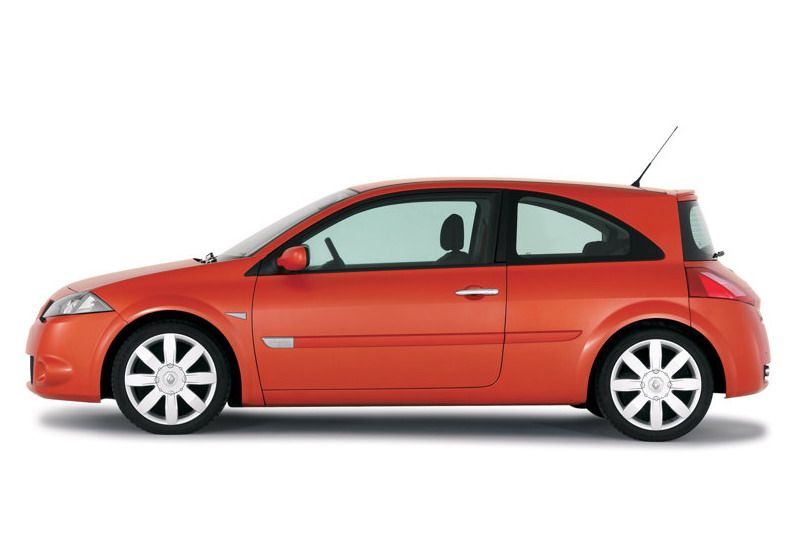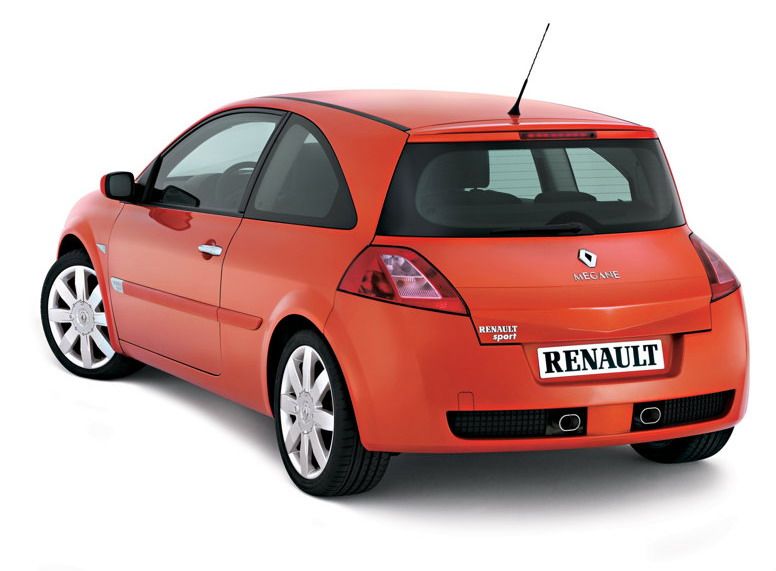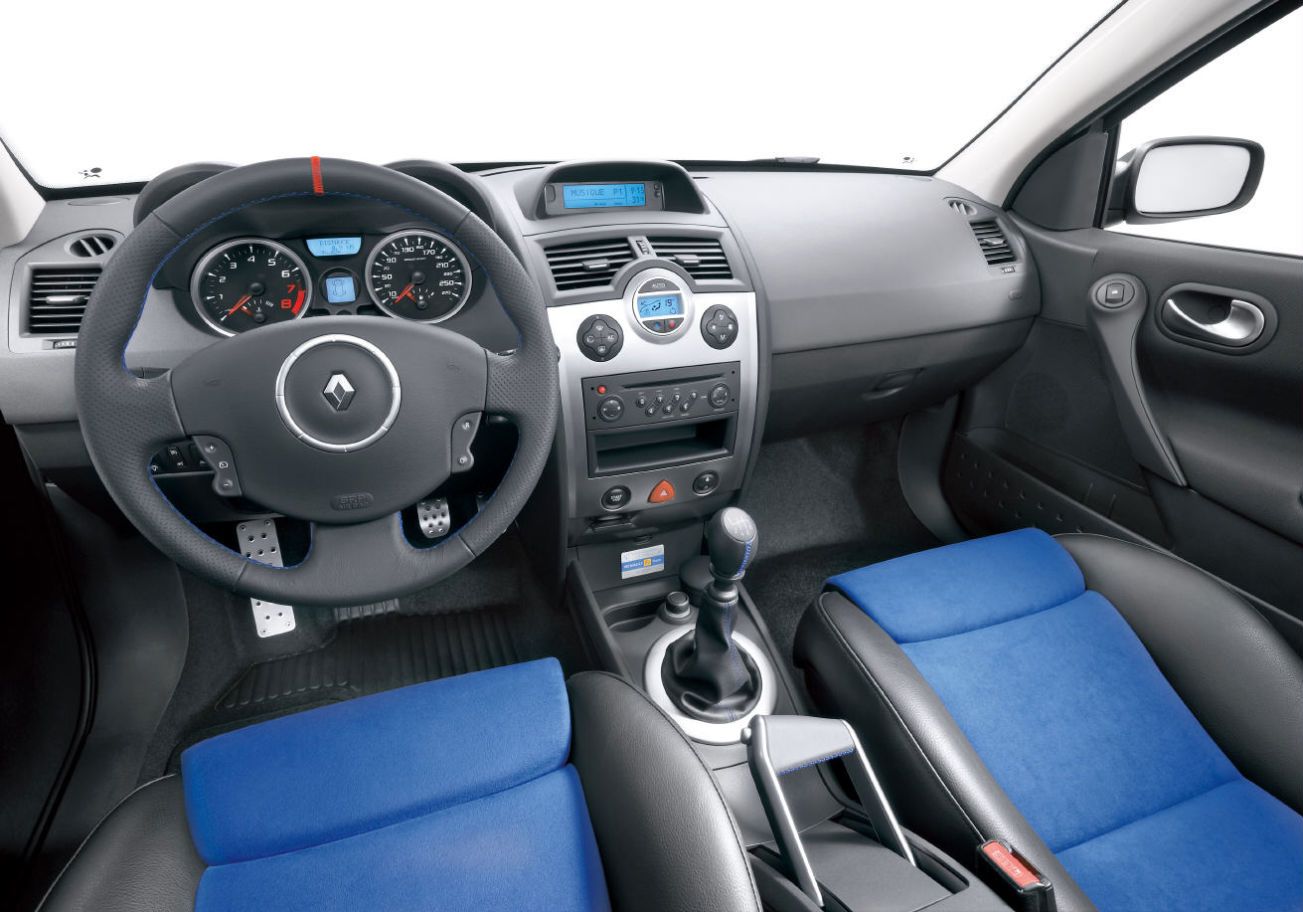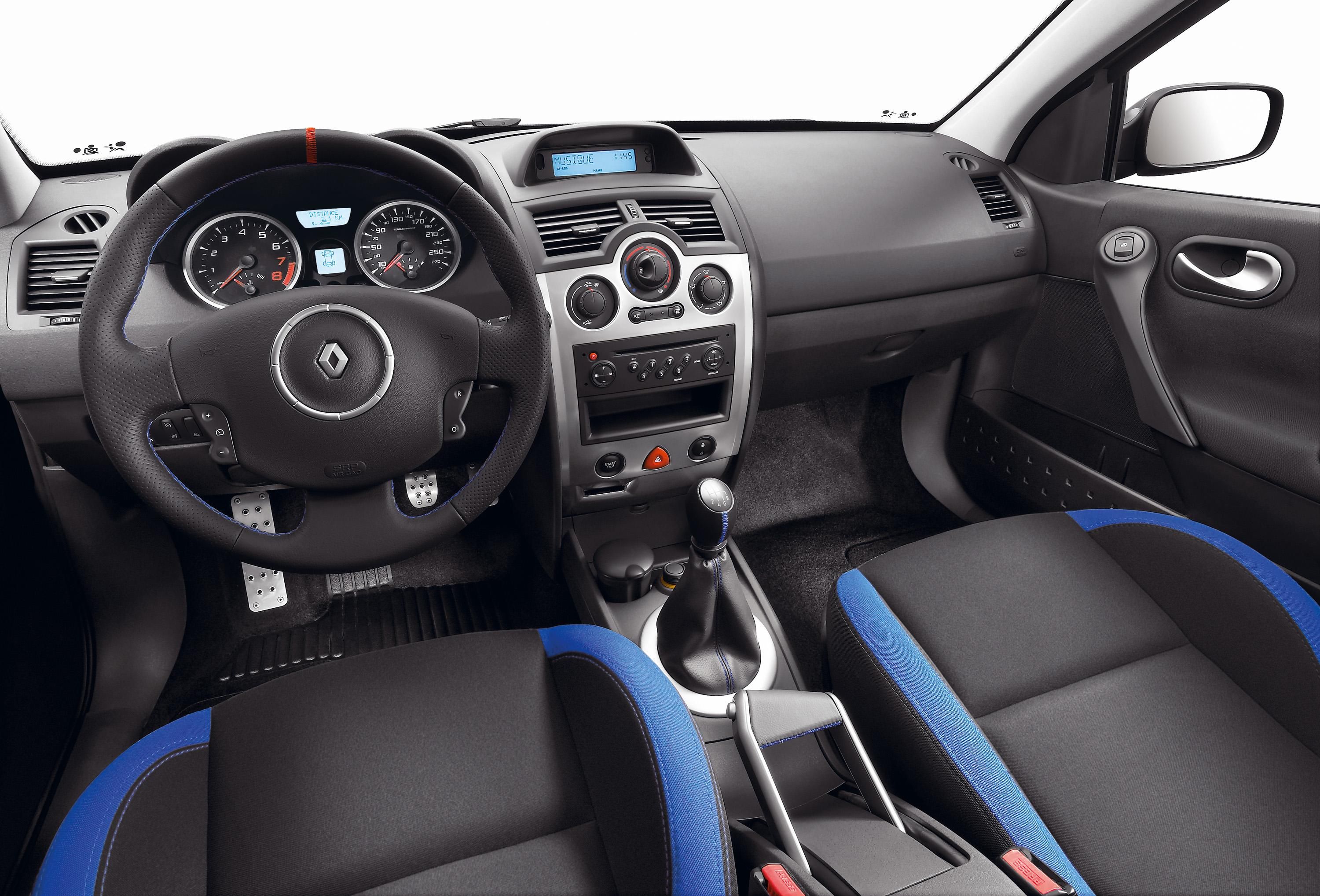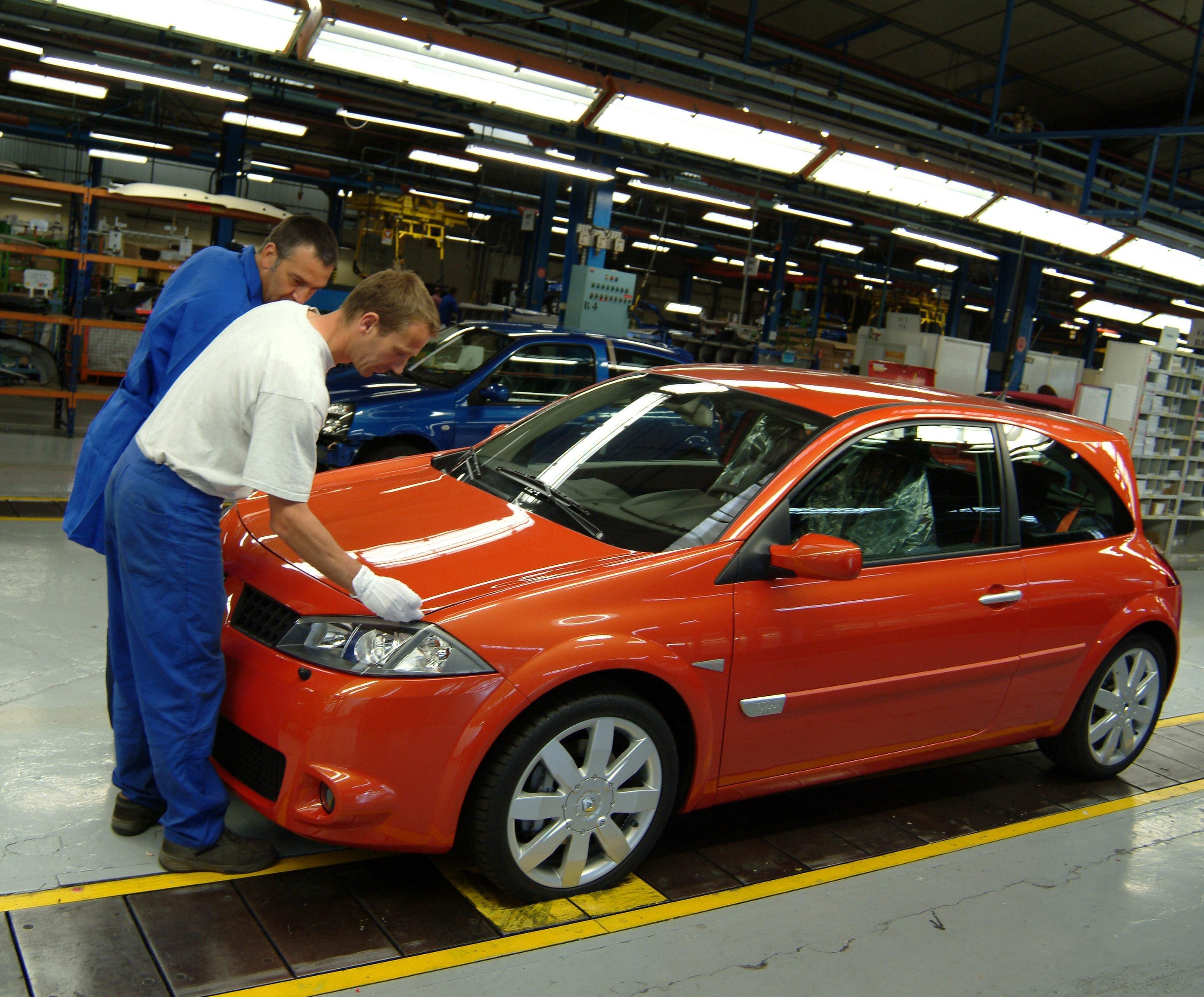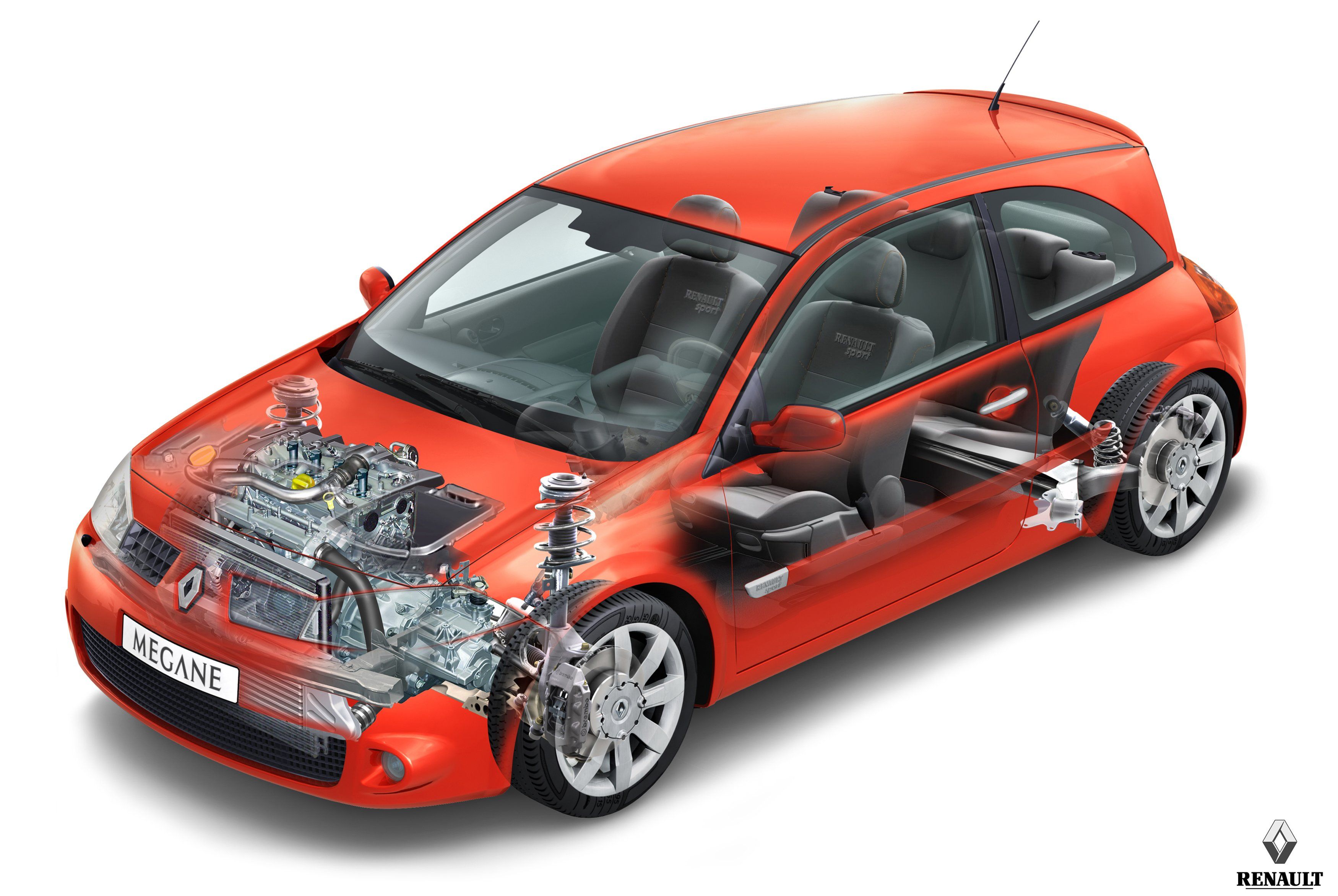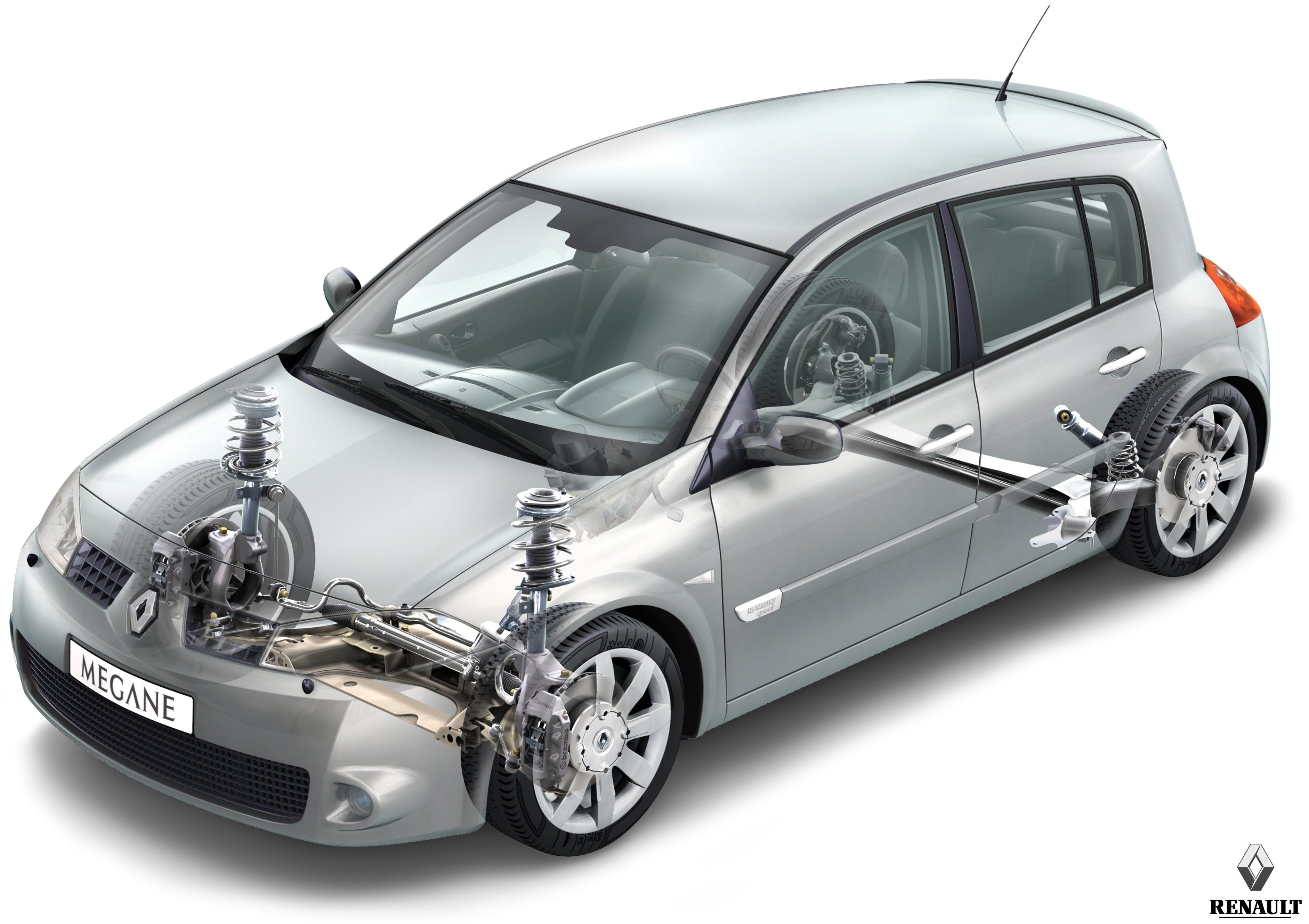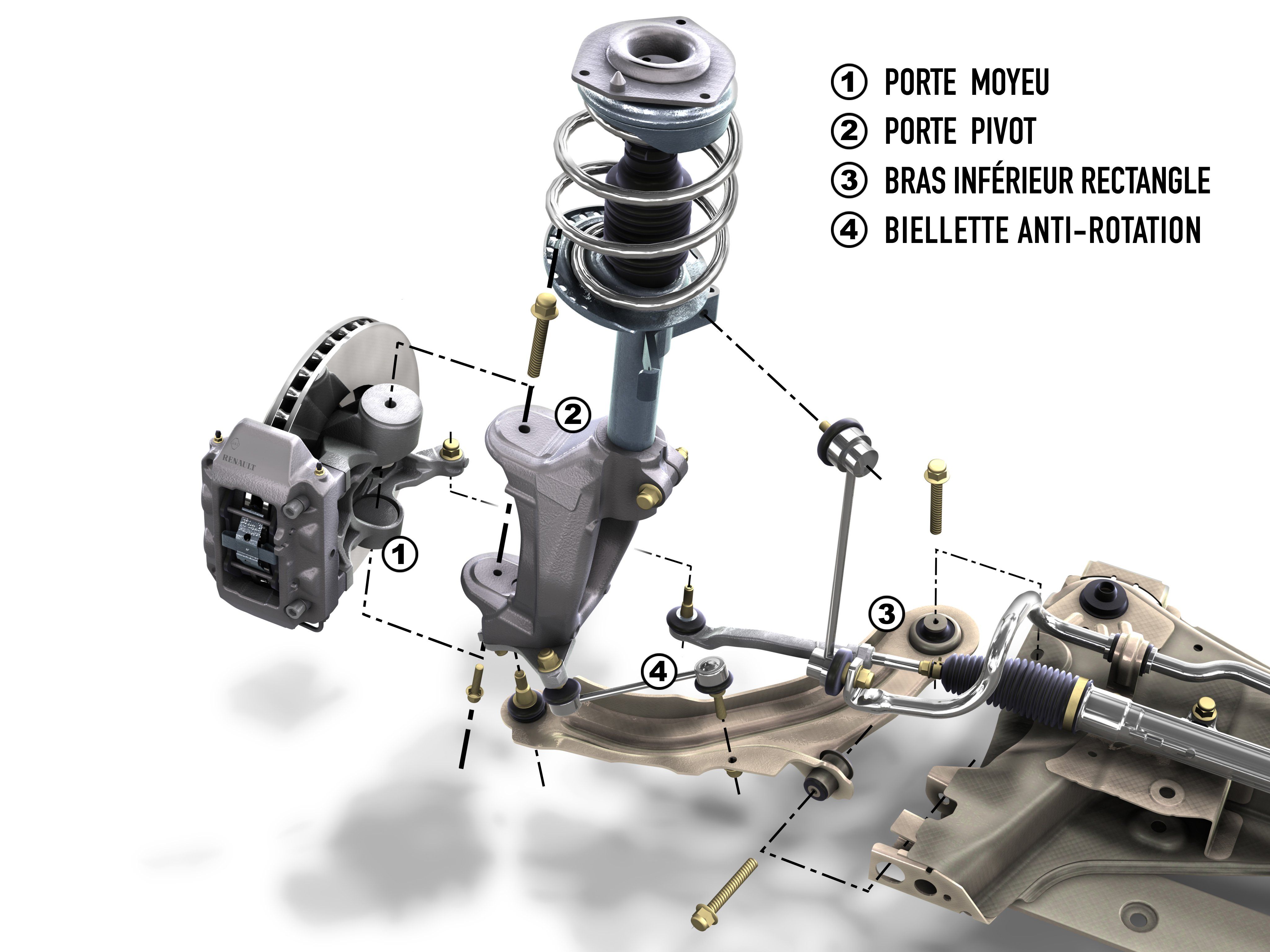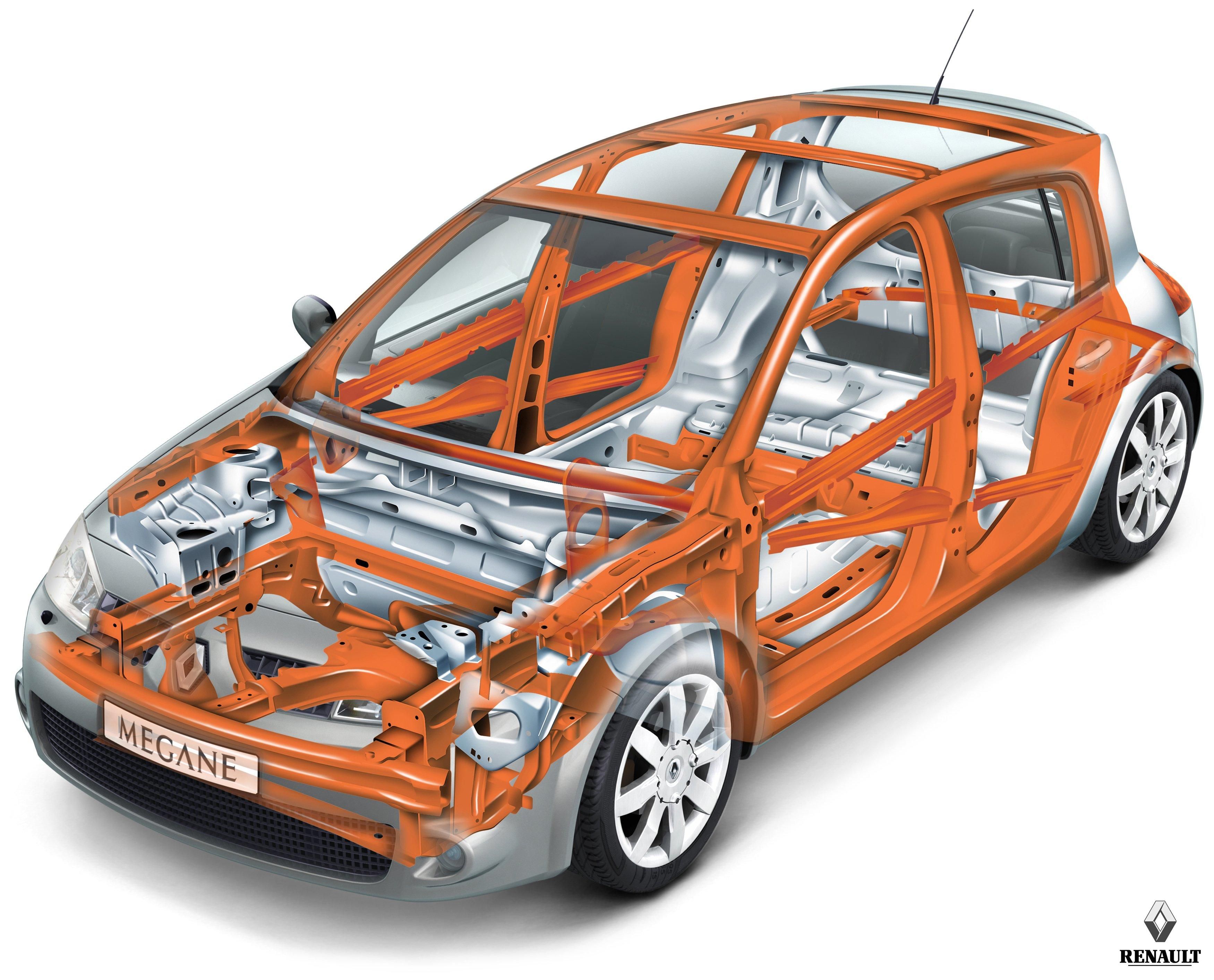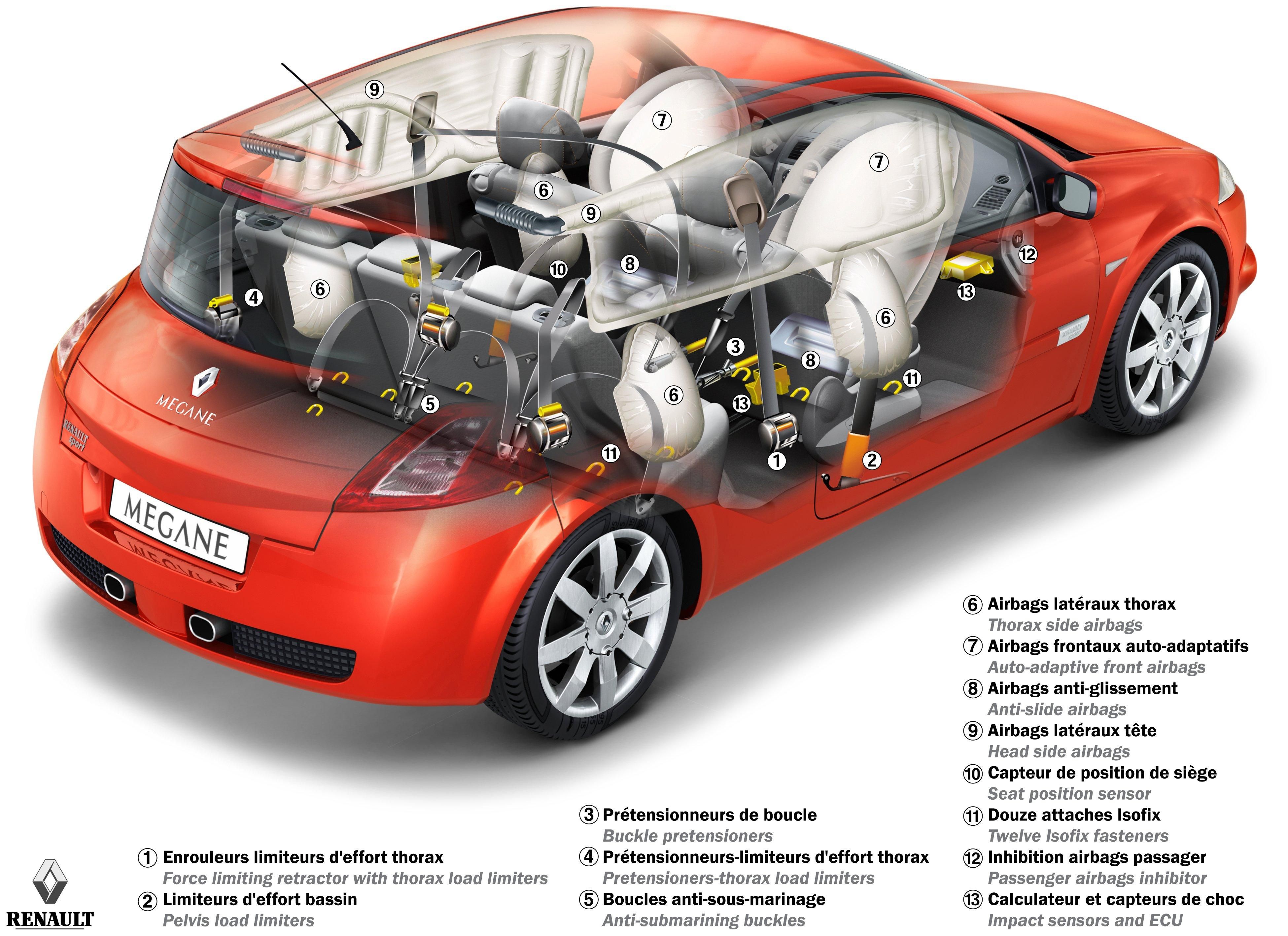Mégane Renault Sport: geared to everyday driving pleasure
The Mégane Renault Sport is the sporting version of the Mégane II programme. It offers both a strong temperament and remarkable ease of use in everyday operation. Its innovative front suspension, a double axis strut system featuring an independent steering axis ensures precision of steering and handling. Together with its 6-speed manual gearbox, its 225bhp 2.0 Turbo engine provides excellent response from the lowest speeds. Offered in 3-door and 5-door form, this sporting version carries over all the comfort and safety features of Mégane II, whose hatchback version was voted “Car of the Year 2003”. The Mégane Renault Sport is built in the Dieppe factory, which is dedicated to manufacture of the brand's sporting cars.
2007 Renault Megane Sport
- Make: Array
- Model: 2007 Renault Megane Sport
- Horsepower: 225@5500
- Torque: 300@3000
- [do not use] Vehicle Model: Array
The Mégane Renault Sport benefits from the lessons of the Mégane II programme and from the expertise of Renault Sport Technologies in the area of sporting cars, for series production or competition. Available in 3-door and 5-door form, it combines the qualities of a grand tourer with the driving pleasure of a sports car.
The “beast” is beautiful
The Mégane Renault Sport presents its sporting character with elegance. Its design is similar to that of Mégane II, whose dynamism and compactness are emphasized by the special features of the Renault Sport models: wide air intake grilles in the bumpers, central twin exhaust pipe, rear wing and 18-inch alloy wheels.
The same character is reflected in the interior design. The deeply curved front seats, and the aluminium pedal cluster and footrest contribute to the sporting air of the cabin interior. The 5 body colours and the 2 interior colour schemes each in their own way reflect the character of the Mégane Renault Sport.
Engineered for precision of control
The Mégane Renault Sport is equipped with an independent steering-axis front suspension. This innovative configuration provides steering precision while eliminating the feedback effects often encountered in very powerful front-driven cars.
The spring and damper settings have been selected to combine dynamic driving with ride comfort. The braking system, powerful and fade-resistant, consists of four large-diameter discs (312mm ventilated at the front and 300mm at the rear), with 4-piston Brembo calipers at the front. The Continental SportContact2 225/40 R18 tyres were specially developed for this application. The variable-assistance steering system and the driving aid systems (ABS, ESP trajectory control with understeer control, ASR traction control with MSR engine torque regulation on the overrun) have been specially recalibrated for the Mégane Renault Sport.
A lively powertrain, strong at all speeds
Renault Sport has developed the 2.0 16v turbocharged engine used in the group’s top-range models into a unit of high performance yet suitable for daily use. Its output of 225bhp with 300Nm of torque is achieved thanks to changes to significant components including the turbocharger, the crankshaft and the pistons.
With at least 90% of maximum torque available from 2,000 to 6,000rpm, this engine provides strong and continuous output. A specially developed exhaust system creates a characteristically sporting sound. The 6-speed manual gearbox allows the liveliness of the engine to be fully exploited: acceleration to 100kph is achieved in 6.5sec and the kilometre is covered from rest in 26.7sec. The Mégane Renault Sport achieves the best fuel consumption in its class with 8.8 litres/100km in the mixed cycle (209g of C02/km) and its exhaust emissions meet the Euro 4 fiscal incentive standard.
The pleasure of being at the controls
The steering wheel and driver’s seat, essential ingredients of driving pleasure, can both be adjusted in various ways to allow anyone to achieve an ideal driving position. The sideways support provided by the front seats, and the location of the cushions, has been improved. The Mégane Renault Sport carries across all the features and innovations of Mégane II, such as the tyre pressure monitoring system and also the cruise control/speed limiter system.
Sportiness with complete safety
Safety is a Renault priority. The Mégane Renault Sport uses the platform and all the safety features which enabled the Mégane II hatchback to achieve a maximum 5-star rating in the crash tests conducted by the independent Euro-NCAP organization. Its structure allows a large amount of energy to be absorbed in the event of an impact. The third-generation Renault System for Restraint and Protection includes adaptive twin-volume frontal airbags together with safety belts with twin load limiters and twin pretensioners for the front seats. Two side airbags protect the thoraxes of front seat occupants and two curtain airbags protect the heads of front and rear occupants. Two side airbags are also offered for the back seats. The Mégane Renault Sport is thus equipped with all the features needed to become the benchmark in terms of passive safety in the sports hatchback segment.
A long-lasting investment
As for the rest of the Mégane II range, service intervals for the Mégane Renault Sport are 30,000km, with spark plugs and air filter required every 60,000km. Its reliability, proven through many durability tests, has allowed the warranty period to be fixed at two years for replacement parts and 12 years against corrosion. In addition, out of respect for the environment, the car has been designed so that it can be easily recycled to the extent of 95% by weight.
The know-how of the Dieppe factory
The Dieppe factory is entirely responsible for assembly of the Mégane Renault Sport, taking body shells from Renault’s production facility at Palencia is Spain. As with the Clio 2.0 16v and V6, the Mégane Renault Sport benefits from the experience and know-how of a site dedicated to the manufacture of the group’s sporting cars.
Positioning and market
The Mégane Renault Sport completes and energizes the Mégane II programme, now consisting of seven body types introduced in 18 months, by entering the market for sporting cars in the C segment. This market has shown strong growth in Western Europe: it has increased from 5,300 units in 1998 to 30,000 units in 2002. After a slight easing of sales through 2003
(25,000 units), associated with ageing of the available models, 2004 will be notable for fresh expansion of the market for compact sporting cars with the most heavily involved manufacturers introducing new models. Following the Clio 2.0 16v, the Mégane Renault Sport completes Renault’s range for this highly competitive sporting market.
-----
Design
The “beast” is beautiful
The exterior design of the Mégane Renault Sport combines the thoroughbred lines of Mégane II with the presence of the Renault Sport badge. Both outside and inside, it evokes at first glance a feeling of dynamism and driving pleasure.
Renault is launching a modern and well-balanced car into the sports hatchback market. It declares its sportiness without ostentation while adopting an approach which reflects driving pleasure.
A family likeness, plus a prestigious badge A wide air intake grille in the front bumper suggests the potential of the engine developed by Renault Sport Technologies. The front foglamps are built into the ends of the bumper.
Characteristic of the “Renault Sport” style, the rear bumper is cut away around the central twin-pipe exhaust outlet. A spoiler integral with the upper part of the rear hatch improves aerodynamic characteristics and increases stability at high speeds.
Together with the generously dimensioned (225/40) tyres, the 18-inch wheels fill the wheel arches. The effect is further to strengthen the robust character suggested by the design of Mégane II. The perforated design of the rims is expressive of speed and shows off the generously dimensioned brake calipers. In this way the Mégane Renault Sport creates an impression of power and of high grip.
The new body colours distinguish the Mégane Renault Sport from other sporting hatchbacks. Each in its own way emphasizes the car’s sporting character: “Blood orange”, “Deep blue”, “Golden black”, “Technical grey” and “Artic blue”.
A definitely sporting interior
The interior colour scheme of the Mégane Renault Sport reflects the exterior design. The idea of “sporty driving” is expressed through the leather steering wheel, the aluminium pedal pads and footrest, and the graphic treatment of the instrument dials. The driving position includes a new instrument layout. The cushion and the side support rolls are deeply curved, to match the sporting character of the Mégane Renault Sport. They can be upholstered, together with the door trim panels, in leather/cloth or plain/perforated leather. The stitching on the seats, steering wheel and door panels, together with the safety belts, are either orange sanguine (bloodorange) or carbon according to the cabin interior
colour scheme.
As in all the products developed by Renault Sport Technologies, the “Renault Sport” badge appears inside the cabin on the instruments, the sill kickplates and the front seats. Outside, the logos at each side and on the rear hatch, together with the engine trim cover, are similarly “badged”.
-----
Chassis
Engineered for precision of control
With its innovative independent steering-axis front suspension, the Mégane Renault Sport combines efficiency with driving pleasure. The entire set-up of the chassis has been redeveloped for this most sporting version of the Mégane II. The power and fade-resistance of the brakes is ensured by using the highestperformance components. The 18-inch tyres allow the potential of the Mégane Renault Sport to be fully exploited. The steering and the driver aid systems have been calibrated for sporting use. MÉGANE RENAULT SPORT
The Mégane Renault Sport carries over the platform design of Mégane II with its wheelbase of 2,625mm. Its front and rear tracks have been increased to 1,517mm (+ 7mm) and 1,521mm (+ 15 mm) respectively to the benefit of stability and grip.
Innovative front suspension
with independent steering axis Renault Sport Technologies has developed a front suspension with an independent steering axis to endow the Mégane Renault Sport with roadholding and traction of the highest level. This new layout maintains the geometric characteristics of the front suspension, especially during hard acceleration or severe cornering.
The spring rates and the 20mm diameter anti-roll bar are adapted to the sporting character of the Mégane Renault Sport, while retaining ride comfort. The front suspension is carried on an isolated sub-frame to limit the transmission of vibrations. A cross-beam has been added between the two arms of the sub-frame to increase its stiffness. The frontend geometry is therefore maintained whatever the applied forces.
Stiffened rear suspension and proven chassis
The rear suspension consists of a programmeddeflection beam whose stiffness of 72 m.daN/° has been increased by 12% compared with Mégane II to achieve optimum roll control during sporty driving. Its mounting points are ideally placed just ahead of and within the wheel axis. This suspension uses coil springs.
The suspension travel to stop contact has been reduced to 65mm at the front and 84mm at the rear. The stiffness of the isolating bushes has been increased by 22% compared with Mégane II and the stiffened damper settings provide the Mégane
Renault Sport with stable and accurate behaviour.
The front suspension with independent steering axis overcomes the drawbacks often encountered in powerful front-driven cars subjected to high forces: self-steeering inputs during tight cornering, and poor straight-line stability (torque-steer).
The steering axis of the Mégane Renault Sport front suspension is completely separate from the damper unit, unlike the MacPherson type arrangement in which the steering axis is defined by the lower swivel joint and the upper attachment of the damper.
The axis around which the wheel rotates forms part of a pivoting link between the hub carrier and an aluminium pivot-carrier. The hub-level offset (the distance between the wheel centre and the intersection of its rotation and steering axes) is thus reduced to 32mm compared with 60mm for the MacPherson type suspension in Mégane II.
The geometry of the front suspension becomes far less sensitive to loads and torques applied to the driven wheels around their steering axes during hard acceleration or braking.
The pivot carrier is attached to the lower suspension arm . It is prevented from rotating by means of a link between the two components. More about the front suspension with independent steering axis
High-performance brakes
The Mégane Renault Sport braking system provides deceleration ability and fade resistance of the first order. Thus a stopping distance of less than 36m can be achieved in 10 consecutive stops from 100kph. The front brakes make use of 4-pot calipers developed by Brembo. The four discs, also supplied by Brembo, are of large diameter (312mm ventilated at the front and 300mm at the rear) and of considerable thickness (28mm at the front and 11mm at the rear).
Brake servo assistance is provided by an 11-inch unit which generates a maximum pressure of 115 bars in the circuit. The latest-generation Bosch 8.0 ABS with EBD allows the rear braking potential to be fully exploited. To reduce stopping distances to a minimum, the Mégane Renault Sport is equipped with emergency brake assist with automatic illumination of the hazard warning lights.
Tyres developed for maximum grip
The tyre plays a determining role in achieving chassis performance. The 225/40 R18-sized Continental SportContact2 was developed for the Mégane Renault Sport. Its tread rubber was developed to ensure the transmission of engine output and braking torque to the road surface.
The cornering grip of these tyres allows the full potential of the chassis to be exploited while providing the driver with full awareness of its behaviour.
Sports type steering
The Mégane Renault Sport is equipped with electric variable assistance steering. The assistance parameters have been recalibrated to ensure an accurate and immediate response to driver input. The calibration of the centre-point detent and the feedback of effort during turn-in to a corner were among the driving fundamentals taken into account during the definition of the assistance parameters.
The progressiveness of the assistance, whatever the steering angle, enables the car to be placed with precision. The degree of effort increases as a function of the car’s speed, with excellent linearity.Equally at ease on the open road or in town, the Mégane Renault Sport has a turning circle between kerbs of 10.35m.
Well-matched driver aid systems
The Mégane Renault Sport is equipped as standard with Bosch 8.0 ESP with understeer control. Its operating threshold is higher than in Mégane II and the manner in which it intervenes has been adapted to suit more dynamic driving. None the less, it contributes to a high level of active safety.
A traction control system (ASR) complements these features to ensure good traction whatever the surface or the acceleration input. The ASR system can be inhibited below 50kph, by way of a dashboard switch, when starting from rest on low-grip or uneven surfaces.
Reconnection is automatic each time the engine is started or when the speed exceeds 50kph. Finally, the engine torque regulation on overrun feature (MSR) modulates the torque output to prevent locking of the driven wheels when the accelerator is suddenly released or when decelerating on a low-grip surface.
-----
Engine and transmission
A lively powertrain, strong at all speeds
The Mégane Renault Sport engine develops power output of 165kW (225bhp) and maximum torque of 300Nm. The shape of the torque curve favours ease of use in everyday driving. The engine drives through a 6-speed manual gearbox to the benefit both of response and fuel economy. The engine note is sporting but refined.
The 2.0 Turbo engine in the Mégane Renault Sport was jointly developed by Renault Sport Technologies and Renault’s Powertrain Engineering Department. It is a development of the 2.0 Turbo engine first seen in Vel Satis
An engine of generous output
This 2.0 16v turbocharged engine (F4Rt) develops power of 165kW (225bhp) at 5,500rpm and maximum torque of 300Nm (30.6 mkg) at 3,000rpm. To provide great flexibility of operation, 90% of this maximum torque is available between 2,000 and 6,000rpm. The increases in power and torque were the result of several changes and optimizations carried out on the pistons, the crankshaft and the twin scroll type turbocharger. This latter benefits from a special turbine and compressor to improve cylinder filling and reduce response time. The fuel injectors are matched to the greater airflow provided by the turbo. The engine is equipped with a specially developed management computer to optimize ease of operation.
A low-inertia twin-mass damping flywheel minimizes excitation of the gearbox by the crankshaft. This feature therefore improves acoustic performance without penalizing pick-up response. The socalled “wide face” cylinder block results in stiffer coupling with the gearbox to the further benefit of acoustic performance.
A 6-speed gearbox:
where acceleration and response are achieved with economy The Mégane Renault Sport engine drives through a 6-speed manual gearbox (ND0) first seen in Mégane II. This Nissan-developed unit is notable for especially precise and fast gearshifting. Its short lever movements and positive detents contribute to driving pleasure.
The special gear ratios improve response in each of the intermediate gears, while fuel consumption and noise levels in motorway driving are reduced. This powertrain allows the Mégane Renault Sport to accelerate from 0 to 100kph in only 6.5 seconds, and to cover a kilometre from a standing start in 26.7 seconds.
At 8.8 litres/100km in the mixed cycle (otherwise 209g of CO2/km), fuel consumption is the lowest among cars of similar power output in the sports hatch segment, while exhaust emissions comply with the Euro 4 fiscal incentive standard.
Carefully tuned sound
The 60mm diameter of the exhaust pipe reduces backpressure which might adversely impact performance. The exhaust note is sporting but refined, with a marked contrast between steady speed and hard acceleration. The Mégane Renault Sport thus provides pleasant listening when the rythm accelerates, without affecting overall driving comfort. The sportiness suggested by the exterior design of the Mégane Renault Sport is reflected within the cabin, where ergonomics are combined with travelling comfort.
-----
Interior
The pleasure of being at the controls
The Mégane Renault Sport cabin interior is dedicated to driving pleasure. The leather steering wheel, the aluminium pedal pads and the front seats with their pronounced curvature are all in tune with the car’s sporting character. Pleasure of operation also results from the many features offered in the Mégane Renault Sport.
Ergonomics which combine efficiency and comfort
The driving position of the Mégane Renault Sport has been designed to provide a made-to-measure fit. The steering wheel is perfectly aligned with the centre line of the seat and provides excellent grip. Recesses for the thumbs make for better precision of steering. The steering column is adjustable for height and reach through a wide range of movement (respectively +/- 20mm and +/- 25mm).
The driver is provided with a large, flat footrest for greater comfort and better location during hard driving. The close grouping and the short movement of accelerator and brake pedals favour heel-and-toe operation.
The feedback of information to the driver is an essential part of driving pleasure. The front seats of the Mégane Renault Sport provide increased sideways support at both shoulder and hip level. The density of the foam has been matched to the damping rate of the car and the pronounced curve at the front of the cushion provides good support for the thighs.
Features which add to the pleasure of driving
Once seated at the controls, the driver benefits from all the features and innovations offered in Mégane II. The tyre pressure monitoring system, the cruise control/ speed limiter, the electrochromic interior mirror and - according to country - the automatic operation of headlamps as well as the automatic variation of wiper speed form part of the standard Mégane Renault Sport equipment specification. With the Renault “hands free” card, unlocking of the car takes place automatically as one of the door handles is lifted. The engine can be started without inserting the card in its slot, simply by pressing a button on the dashboard while also depressing the brake or clutch pedal. The low noise level inside the Mégane Renault Sport allows the Cabasse audio system with its 6 loudspeakers to be fully appreciated.
Two on-board navigation systems are offered: Carminat Turn-By-Turn Guidance and Carminat Navigation System. The latter includes a wide screen which folds away and whose tilt can be adjusted. According to choice, the headlamp dipped beams are equipped either with halogen or xenon discharge bulbs.
-----
Safety
Sportiness with complete safety
Safety is a priority and a particular area of Renault expertise. The Mégane Renault Sport has in its genes all those elements needed for it to become a benchmark for passive safety in the sports hatchback segment. With the structure and the full range of safety features found in Mégane II, the Mégane Renault Sport provides optimum safety for all seating positions.
The passive safety of the Mégane Renault Sport resembles its image of velocity: remarkable efficiency. It forms part of the Mégane II line, thus of the first compact hatchback to achieve a maximum 5-star rating in the crash tests conducted by the Euro- NCAP organization.
A benchmark structure
The front, rear and sides of the Mégane Renault Sport absorb the energy associated with impact while preserving the cabin interior. Its structure possesses the ability to absorb and to dissipate large amounts of kinetic energy thanks to the use of new steels and other materials first seen in Mégane II.
Optimum safety for all occupants
An excellent balance between the energy-absorbing ability of the structure and the means of occupant restraint has been achieved. The Mégane Renault Sport is equipped with the third-generation Renault System for Restraint and Protection which has been fitted to all the group’s new models since 2001. For the front seats, this system combines double-volume adaptive airbags and safety belts with twin load limiters (600 daN at pelvis level and 400 daN at thorax level). Coupling of occupant to seat is achieved through double pretensioners for the front seats, with two pyrotechnic pretensioners in the 5-door or a pretensioner and an anti-submarining airbag in the 3-door.
The Mégane Renault Sport is equipped with two thorax side airbags for the front seat occupants; two side airbags are also offered for the back seat. Two curtain airbags provide protection for the heads of both front and rear occupants, whether adults or children. All the airbag operation settings have been modified to match them to the specification of the car’s chassis.
The back seat passengers are provided with 3-point inertia-reel safety belts which embody a 600 daN load limiter and a pyrotechnic pretensioner in the case of the two outer sitting positions. The Mégane Renault Sport provides a system of 3-point Isofix attachments for child safety seats, forward or rear-facing, for the two rear outer seat positions and the front passenger seat. A secure switch allows the safety equipment of the front seat to be inhibited. A dashboard indicator light is illuminated when these safety features are inhibited.

